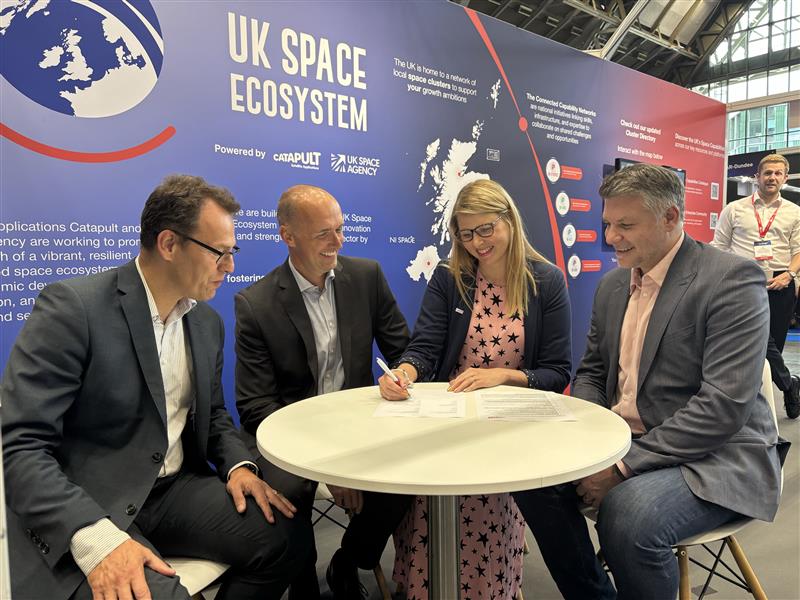Harwell Science and Innovation Campus, Space East and the Westcott Space Cluster formally signed a Memorandum of Understanding (MOU) at the 2025 UK Space Conference, marking a significant step towards accelerating cross-regional collaboration across the UK’s growing space sector. This initiative aligns with the UK’s National Space Strategy and reflects the growing importance of regional cluster collaboration in delivering national impact.
Facilitated with support from the Satellite Applications Catapult (SAC) and funded by the UK Space Agency, this strategic agreement brings together three of the UK’s leading local space clusters in a coordinated effort to progress innovation, investment, and skills development across the Oxford-Cambridge corridor and wider UK space ecosystem.”
The MOU outlines a shared commitment to develop a Pan Cluster Partnership, building on regional strengths and enabling a joined up approach to growing the UK’s space ecosystem. It will also support and build on existing national initiatives, including the SAC’s Connected Capabilities Networks (CCNs).
The initiative will begin later this month with a UK Space Agency-funded Pilot Phase. During this time, the partners will work to:
- Develop a pan-regional capability map to identify shared strengths and attract inward investment;
- Promote regional capabilities and the benefits of collaboration to industry, academia, and government;
- Deliver joint events to foster engagement and knowledge exchange
- Drive innovation, economic activity, and skills development across the corridor ; and
- Pave the way for future phases that will sustain momentum and deepen impact.
“This partnership will showcase how we can develop collaboration between clusters to drive national impact. By strengthening links across the UK’s space clusters, we’re aiming to accelerate innovation, support new businesses, and help to position the UK to be at the forefront of global space capability,” said Dr Hugh Mortimer, Harwell’s Space Cluster Manager.
Stuart Catchpole, Regional Director for Space East said “This MOU marks a major milestone in our collective ambition to build a more connected and competitive UK space sector. The East and South East of England is a region of national strategic importance in the UK, uniquely positioned due to its concentration of innovation, science, and technology assets. Through enhancing collaboration, we can amplify the impact of each cluster and unlock the potential of the Oxford-Cambridge corridor as a national and international leader in space-enabled innovation.”
Ian Barham, Westcott Space Cluster Lead, said “We are delighted to be part of this exciting new collaboration with Space East and Harwell to establish a regional space cluster for the East and South East of England. This partnership represents a major step forward in strengthening the UK’s space ecosystem, and we look forward to working together to drive innovation, investment, and opportunity across the region.
Our shared ambition is to create a connected and collaborative network that supports the growth of high-tech businesses, accelerates the development of space technologies, and enhances the UK’s global competitiveness in the space sector.”
“This is a hugely exciting moment for the UK space sector,” said Simone Hartless, at the Satellite Applications Catapult. “Bringing together the strengths of Harwell, Westcott and Space East is not just a strategic step, it’s a powerful signal of what we can achieve when we work as a connected, collaborative community. We are proud to have supported the development of this partnership, and we look forward to seeing the innovation, energy and opportunities it will unlock across the region from Oxfordshire, Buckinghamshire through to the East of England and beyond.”
Antonia Yendell, Head of Space Ecosystem Development at the UK Space Agency said “The partnership between Space East, Harwell, and Westcott represents exactly the kind of strategic collaboration that will drive the UK space sector forward.
“This connected approach strengthens our entire space ecosystem and reinforces the UK’s position as a leader in space innovation. We’re proud to support this partnership, which exemplifies how collaboration can unlock new opportunities and accelerate growth across our thriving space sector.” The signing took place during the 2025 UK Space Conference, underscoring the national importance of the partnership and its alignment with the UK’s wider space strategy.”

From left to right:
- Ian Barnham – Partnerships Director for Buckinghamshire Council
- Dr Hugh Mortimer – Space Cluster Manager for Harwell
- Simone Hartless, Head of Capabilities and Clusters at Satellite Application Catapult
- Stuart Catchpole – Regional Director for Space East
